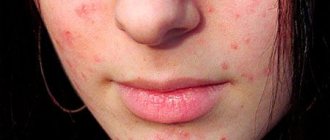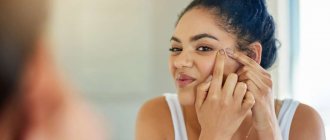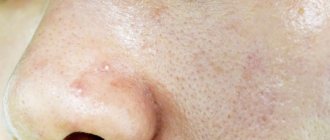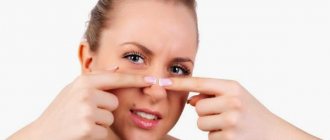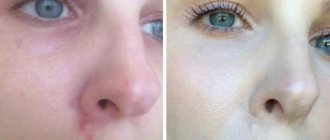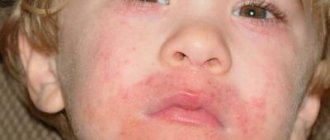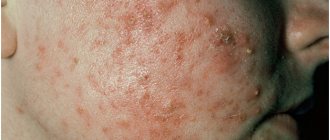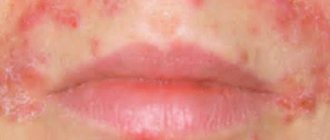Every person faces the problem of how to squeeze out an internal pimple at least once in their life.
A small dense formation, when pressed, you may feel a slight tingling sensation, and sometimes acute pain. Unlike its visible relatives, aesthetically it brings a minimum of inconvenience. The structure of the skin remains almost unchanged, the redness is inexpressive and can be easily hidden with corrector or powder. But the effect of latent suppuration is like a time bomb, with completely unpredictable consequences. Even open acne, if removed on its own, poses a threat of spreading infection. If the inflammation is concentrated inside the sebaceous gland, the task becomes much more complicated.
Causes
How to squeeze out an internal pimple
correctly and not get complications, tissue scarring or sepsis? First, it is worth understanding why it was formed, so as not to provoke a new appearance. Increased secretion of the sebaceous glands leads to clogging of the ducts with already hardened plugs. Under such covers, subcutaneous substance continues to accumulate; the principle of action is similar to a volcanic eruption.
- Poor circulation of the facial vessels leads to uneven distribution of sebaceous secretions. This is a natural moisturizer to maintain youthful and elastic skin. Sometimes such a natural cream can easily cause the spread of infection;
- the general immune state of the body and protective functions do not work one hundred percent. In this case, this is a green light for the proliferation of pathogenic life forms.
- hormonal changes during adolescence, pregnancy or disruptions in the endocrine system are immediately reflected on the face;
- lack of proper skin care, especially typical for oily and combination skin types. Without cleansing the top layer of the epidermis, it is easy to get complex dermatological diseases. A small pimple becomes a reason to change the structure of the entire face;
- Poor nutrition, love for fast food, snacks and soda often manifests itself as on litmus paper in the form of internal pustules.
Types of acne
Acne, or acne, is an inflammatory disease of the skin appendages (sweat and sebaceous glands, hair follicles). This problem is in 1st place in prevalence among all skin diseases, since the glands begin to actively function in newborns, and stop working in old age.
In women, this problem occurs more often, but at 10-12 years of age, the rash occurs with approximately the same frequency in boys and girls. The overwhelming majority of pathology is genetically determined: a certain set of genes responsible for the quality, quantity and structure of the sebaceous glands and their sensitivity to external and internal influences is inherited from parents.
Depending on the depth of skin damage and the presence of inflammation, the main types of acne are distinguished:
- "Whitehead" (milium): pimples in the form of grains of rice. The rash element is located in the upper layer of the skin; it is a dense cyst of the sebaceous gland. The nodule is painless, up to 3 mm in size.
- “Blackhead” (open comedon): the well-known blackheads. Sebum, dust, and cosmetic residues accumulate in enlarged pores. Ferrous secretions are initially white, but when exposed to air they oxidize and darken.
- White (closed) comedones are the same as black ones, but before oxidation. Due to the blockage of the pore with a thin layer of the epidermis, its contents accumulate inside, and a protrusion is formed - a tubercle, which can be determined by touch. The color of the seal does not differ from the surrounding skin or may be lighter than it.
- Papule: its predecessor is a closed comedon. The secretion of the glands accumulates in the pore and does not find a way out, and inflammatory cells delimit it from the surrounding skin. A dense nodule of 1-3 mm is formed, which can become inflamed due to injury (one of the reasons why you should not squeeze pimples).
- Abscess: inflamed nodule. The glandular secretion suppurates, and an inflammatory “ridge”—redness—forms around it. Pus is visible in the center of the pimple; may result in severe pain.
How to delete?
If professional dermatologists are temporarily unavailable, you can carry out the entire process yourself at home:
- Be sure to remove decorative cosmetics, not with ordinary water, but with micellar or thermal water. Treat the area with the internal formation with salicylic acid;
- then, pressing lightly with two fingers, very slowly stretch the pimple. For complete control of the operation, the mirror should be placed in front of the window or take an additional powerful light source;
- if such manipulations cause acute pain and do not produce results, you should use a syringe needle. Do not use without packaging or with damaged wrapper. Treat the needle with alcohol or sterilize it over a fire for about a minute, then slowly insert it into the center of the lesion (determined by a barely noticeable point) from the side. First, blood will appear, since the integrity of the integument is affected, then a white/yellow mass;
- when the pus comes out, perhaps a thicker core, a clear liquid should appear upon completion. A drop of blood indicates complete removal of the internal pustule;
- After treating the area with an antiseptic, leave for the normal healing process. The next day a crust forms; you need to wash your face and apply cosmetics very carefully so as not to damage it;
- for a week you will need to forget about any cosmetic procedures - peelings, scrubbing, masks, steaming, massages. For makeup, choose anti-comedogenic products in a pharmacy or specialized stores.
Why shouldn't you squeeze pimples?
“I always recommend that patients resist the temptation to pop pimples. This may seem like the simplest solution, but it often only makes the problem worse. Here's why: When you squeeze a pimple, you literally tear the skin. This can damage the infected follicle and thereby increase inflammation.”
By squeezing pimples, you expose yourself to a double risk: firstly, scars may remain, and secondly, even more pimples may appear. Dermatologists are unanimous in their concerns: traumatization of inflamed elements can lead to the formation of scars.
There is a high risk that the infection from the first outbreak, due to physical impact at the time of squeezing, can spread to adjacent areas of the skin. All this can be aggravated by bacteria that enter the inflammation site from dirty hands or nails.
No matter how tempting the idea of quickly getting rid of a pimple by squeezing it out with your hands may be, you should not do this. If there is only one pimple on your face, you can go to a cosmetology office to have a specialist remove it professionally. However, it is more reasonable to disguise this unexpected pimple with a concealer in order to quickly solve the problem. And then consult a doctor if acne continues to appear.
What can't you do?
Re-formation of internal pus pustules can be easily provoked if:
- not cleansing your skin on time with high-quality products for your type, going to bed with makeup as if for a photo shoot. Everyone has access to folk remedies that allow them to take care of their face and spend a minimum of money and time;
- squeeze out an immature pimple, the infection will spread in unknown directions in the inner layers of the dermis. You must wait at least three days, constantly treating the problem area;
- use alcohol tinctures - they dry out the skin and have no effect on subcutaneous infections;
- sharply, using all the strength and desire to get rid of the hated formation. Scarring of the tissue is guaranteed, and complications can lead to hospitalization;
- You should never touch pimples in the dangerous nasolabial triangle, there is a direct connection between blood circulation and the brain.
Is it possible to squeeze pimples?
The last thing you want is for others to see this “sudden guest” on the tip of your nose. The first thought is not to wait for the pimple to burst or go away on its own, but to be determined and squeeze it out entirely. After all, it seems that redness from a squeezed pimple is not as scary as a blackhead or a white pustule.
Unfortunately, getting rid of acne is not so easy. If you squeeze them out, the situation can worsen radically
. This is the first thing doctors tell all their patients. Dermatologist Philippe Beaulieu explains why you should never get rid of acne on your own.
Prevention
You can maintain the beauty and health of your skin without visiting a dermatologist or spending fabulous sums on masterpieces of branded cosmetics:
- washing with cold water and wiping the face with ice cubes activates blood circulation and lymph flow, normalizing internal processes in all layers of the epidermis;
- if acne forms on the body, you can take a course of medicinal baths. Sea salt, herbal decoctions and essential oils restore the functioning of protective integuments;
- start every morning with a glass of high-quality warm water; a simple habit does a good job of cleansing the intestines of harmful microflora, the main supplier of pustules on the face;
- review your diet, reduce the amount of sweet, salty, canned food. Vegetables, fruits and dairy products are the best helpers for clear skin;
- cleansing, toning, moisturizing - morning and evening, once a week - scrubbing, once a month - peeling - this is our father for the face;
- do not overdo it with decorative cosmetics, hiding aesthetic imperfections behind tons of heavy makeup. Thus, it is easy to cut off the supply of oxygen to the cells. And this is already fraught with premature aging.
At home, you can solve a cosmetic problem and take care of skin health. How to squeeze out an internal pimple and not be left with a scar is to adhere to simple hygiene standards. If the formation begins to appear regularly, consultation with a dermatologist and endocrinologist is mandatory.
To push or not to push. 9 Myths About Acne You Should Stop Believing
Acne on the face is not only a problem for young people. Even if you passed adolescence twenty or even thirty years ago, this does not guarantee ideal skin without inflammation and blackheads. What to do with the problem, and most importantly, how not to aggravate it, says cosmetologist Inna Feronova .
1. We think : under no circumstances should you squeeze out pimples, otherwise there will be even more of them. However, if the pimple is “ripe”, it is better to get rid of it.
In fact : you can squeeze out pimples, but you need to do this with all the necessary precautions: wash your hands, treat the area where the pimple appears with a disinfectant (pharmaceutical alcohol or hydrogen peroxide) twice. Keep in mind that there are places on the face where you shouldn’t remove pimples yourself, as this is fraught with consequences: for example, purulent meningitis. These include the area of the wings of the nose and the nasolabial folds: there are blood vessels that supply the brain with blood. If disinfection rules are not followed, the infection can enter the bloodstream. It is also strictly forbidden to squeeze out pimples with yellow or green pus on your own. Another important point: acne is just the tip of the iceberg. In order to get rid of them, it is necessary to establish the cause of their occurrence, and this can only be done by a specialist - a dermatologist. Another compelling argument in favor of seeking medical help when it comes to acne is the risk of scarring at the site of a self-squeezed pimple.
Article on the topic Dangerous spots. Signs of which “female” diseases can be seen on the skin of the face
2. We think : the more sweet and fatty foods in the diet, the more acne on the face.
In fact : this point of view is long outdated. Experts do not associate the appearance of acne with flaws in the patients’ diet. Of course, having problem skin is a reason to reduce the amount of spicy, salty or sweet foods in your diet to a minimum. But that's not why acne occurs. There are a huge number of causes external (exogenous acne) and internal (endogenous acne) that lead to acne. In the first place are hormonal changes (puberty, premenstrual syndrome, pregnancy, etc.), the presence of endocrine diseases and problems with the gastrointestinal tract. The second is improper skin care. On the third - stress, ecology, bad habits. Also, the appearance of acne can be caused by taking hormonal drugs and steroids.
3. We think : professional facial cleansing at least once a month will minimize the risk of acne.
Fact : Acne is a disease that requires systemic treatment. Without establishing the cause of its occurrence and without undergoing a course of treatment, which involves taking appropriate medications and using ointments, you will not be able to get rid of acne, no matter how many times you do professional facial cleansing.
There are 3 degrees of acne severity: mild - no more than 10 acne without pronounced signs of inflammation, moderate - from 10 to 40 acne elements, and severe - more than 40 purulent elements. Treatment of acne directly depends on the severity of the disease. Mild acne involves local treatment with creams or ointments based on antibiotics and keratolytics with the addition of antiseptic ingredients. Such ointments help reduce sebum production. Moderate and severe forms of the disease require constant medical supervision; it is possible to take medications (antibiotics). From the “office” treatment, in addition to mechanical cleansing, patients with acne are shown chemical and laser peels. Phototherapy and cryotherapy (cryodestruction, cryomassage, etc.) give good results in the treatment of acne.
Article on the topic
Sallow complexion and acne. 8 signs that it's time for you to see a doctor
4. We think : foundation causes acne because it clogs pores.
Fact : This is one of the most common myths about acne. Modern high-quality foundations do not clog pores. Buy proven brands and don’t skimp on your health. Remember, a good foundation cannot be cheap. By the way, acne can be caused by an incorrectly selected face cream for your skin type. Some product may simply not be suitable for you and may cause an allergic reaction. Acne may appear because you neglect creams with UV protection. As a rule, problem skin is sensitive, so it requires more attention and care. Do not forget also about regular hygiene of those items that you use to apply foundation and other products. “Centuries-old” dirt on sponges, brushes and applicators is another reason for the appearance of exogenous acne.
5. We think : a clay mask helps fight acne.
In fact : I still wouldn’t put much faith in the miraculous powers of homemade masks to treat acne. I repeat, acne is a serious disease that requires identification of the causes and competent treatment from a specialist. A clay mask is a good remedy if you have oily or normal skin and pimples appear on it occasionally. But under no circumstances should you use it if your skin has inflammation, ulcers, or other serious problems!
Article on the topic
Elements of youth.
How to choose the right face cream 6. We think : if you don't have any medicine on hand, you can burn the pimple with toothpaste.
In fact : traditional medicine knows many ways to treat a wide variety of diseases. How successful she was in this is a big question. As a dermatologist, I cannot give advice on using toothpaste as a remedy for acne. If you encounter this problem regularly, try to have pharmaceutical antiseptics at home. In general, having a first aid kit at home is useful not only for acne. You should not aggravate your skin problems with the help of folk remedies - it is better to go to the pharmacy and buy hydrogen peroxide, calendula tincture, salicylic or boric alcohol, ichthyol or tetracycline ointment. All these products are applied pointwise and perfectly dry the area of inflammation.
7. We think : acne appears due to irregular sex.
In fact : another myth that has taken root in our minds for so long that it seems impossible to eradicate it. Many years of medical practice show that acne and the presence or absence of sex in a patient’s life are in no way connected. Again, the causes of acne can be external or internal, for example, hormonal or associated with taking any medications. In this case, oral contraceptives may be prescribed to treat acne. Despite the fact that the activity of the sebaceous glands is regulated by sex hormones, the absence of sex does not affect the production of skin secretion, nor does its presence.
Fat, dryness, pimple. The ABCs of caring for different skin types Read more
8. We think : if you scrub 1-2 times a week, it will help in the fight against acne.
In fact : this is where you need to be extremely careful. Problem skin is most often sensitive, so it is afraid of aggressive influences. Namely, this happens to skin that is intensively scrubbed. Only those whose skin is of normal type without signs of inflammation, especially without acne, can afford to use a scrub once a week. Scrubs are contraindicated for acne! If you have sensitive skin (dry or oily), use more delicate cleansers, such as gommages, for home care. And if the skin is problematic, then it is better to coordinate home care with a dermatologist and strictly follow his recommendations.
9. We think : acne heals faster in the sun.
In fact : the sun can provoke a new round of acne, so for problem skin it is recommended to constantly use SPF cream before going outside, even in winter.
